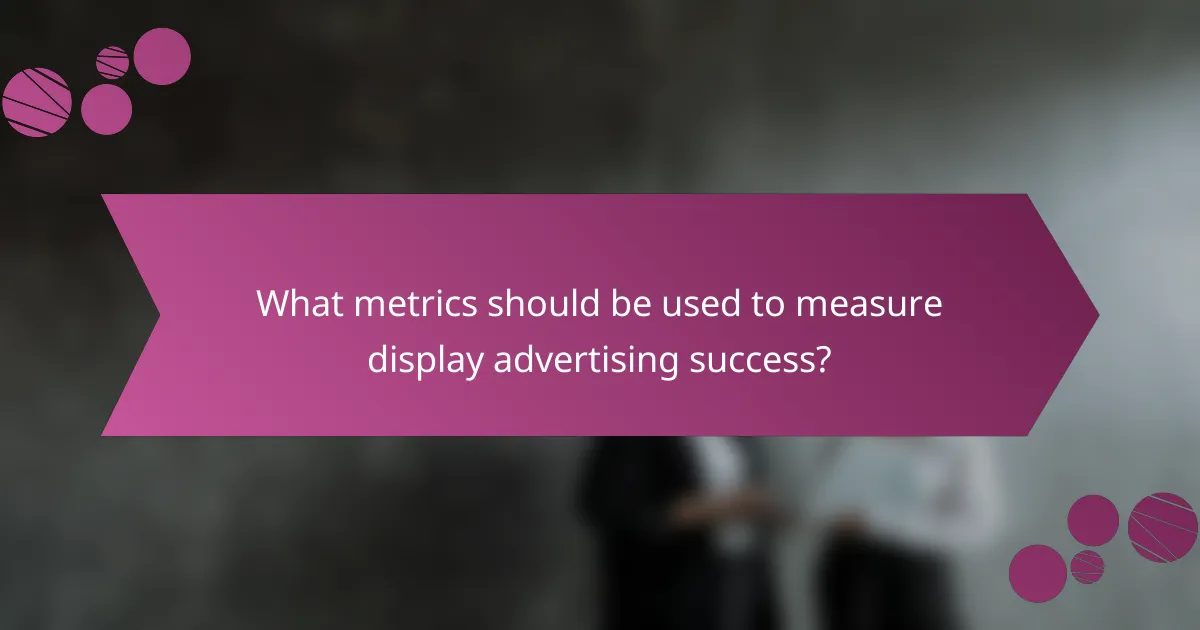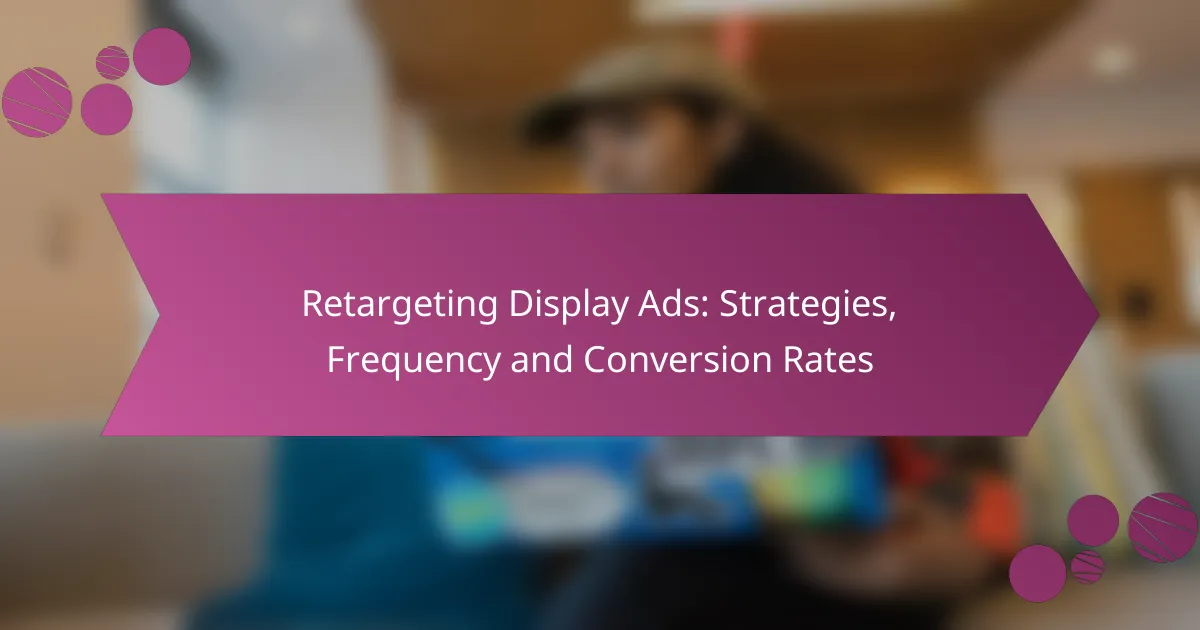In the competitive landscape of display advertising, selecting the right platform is crucial for maximizing audience reach and cost efficiency. Platforms such as Google Display Network, Facebook Ads, and LinkedIn Ads each provide unique targeting capabilities that can significantly enhance campaign effectiveness. By carefully evaluating these options, advertisers can ensure their messages connect with the right demographics, ultimately leading to a better return on investment.

Which display advertising platforms are most effective in Ireland?
The most effective display advertising platforms in Ireland include Google Display Network, Facebook Ads, AdRoll, Amazon Advertising, and LinkedIn Ads. Each platform offers unique advantages in terms of audience reach, targeting capabilities, and cost efficiency, making them suitable for various advertising goals.
Google Display Network
The Google Display Network (GDN) is a powerful platform that allows advertisers to reach a vast audience across millions of websites, apps, and videos. It offers robust targeting options, including demographic, interest-based, and remarketing strategies, making it ideal for both brand awareness and conversion-focused campaigns.
Advertisers in Ireland can benefit from GDN’s cost efficiency, with average costs per thousand impressions (CPM) typically ranging from €1 to €5. To maximize effectiveness, consider using responsive display ads that automatically adjust in size and format to fit various placements.
Facebook Ads
Facebook Ads provide access to a highly engaged audience, with detailed targeting based on user interests, behaviors, and demographics. This platform is particularly effective for brands looking to foster community engagement and drive traffic to their websites.
In Ireland, the average cost per click (CPC) for Facebook Ads can vary, often falling between €0.20 and €1.00. To optimize campaigns, utilize A/B testing to refine ad creatives and targeting, ensuring the best return on investment.
AdRoll
AdRoll specializes in retargeting, helping brands reconnect with users who have previously interacted with their website or app. This platform is effective for driving conversions by reminding potential customers of products they viewed but did not purchase.
In Ireland, AdRoll’s pricing structure typically includes a mix of CPM and CPC models, making it flexible for different campaign types. Advertisers should focus on creating compelling ad creatives that encourage users to return and complete their purchases.
Amazon Advertising
Amazon Advertising allows brands to promote their products directly on the Amazon platform, reaching consumers who are already in a buying mindset. This is particularly beneficial for e-commerce businesses looking to increase visibility and sales.
Costs on Amazon Advertising can vary significantly based on competition and product category, with CPC often ranging from €0.30 to €2.00. To enhance effectiveness, optimize product listings and use high-quality images to attract clicks.
LinkedIn Ads
LinkedIn Ads are tailored for B2B marketing, allowing businesses to target professionals based on job title, industry, and company size. This platform is ideal for generating leads and building brand authority within specific professional niches.
In Ireland, LinkedIn Ads typically have higher CPC rates, often between €2.00 and €6.00, reflecting the platform’s premium audience. Advertisers should focus on creating informative content that resonates with their target audience, such as whitepapers or case studies, to drive engagement and conversions.

How to choose the right display advertising platform?
Choosing the right display advertising platform involves assessing audience targeting, evaluating costs, reviewing ad formats, and considering integration with existing tools. A well-selected platform can enhance your campaign’s effectiveness and ensure optimal return on investment.
Assess audience targeting capabilities
Audience targeting is crucial for reaching the right consumers. Look for platforms that offer advanced targeting options such as demographics, interests, behaviors, and retargeting capabilities. The more precise the targeting, the higher the chances of engagement and conversion.
Consider platforms that provide data-driven insights to refine your audience segments. For example, Google Display Network allows you to target specific user interests and behaviors, enhancing the relevance of your ads.
Evaluate cost structures
Understanding the cost structures of display advertising platforms is essential for budget management. Common pricing models include cost-per-click (CPC), cost-per-thousand impressions (CPM), and cost-per-acquisition (CPA). Choose a model that aligns with your campaign goals and expected outcomes.
Compare the average costs across different platforms. For instance, CPC rates can vary significantly, with some platforms offering lower rates for specific niches. Always consider the potential return on investment when evaluating costs.
Review ad format options
Different ad formats can influence user engagement and brand visibility. Look for platforms that offer a variety of formats, including banner ads, video ads, and interactive ads. Each format serves different purposes and can appeal to various audience preferences.
For example, video ads tend to have higher engagement rates compared to static banners. Assess which formats are most effective for your target audience and campaign objectives to maximize impact.
Consider integration with existing tools
Integration with your current marketing tools can streamline your advertising efforts. Choose platforms that easily connect with analytics, CRM systems, and other marketing software you use. This ensures a cohesive strategy and better data management.
For instance, platforms like Facebook Ads Manager integrate well with social media analytics tools, allowing for comprehensive performance tracking. Evaluate how well a platform can fit into your existing workflow before making a decision.

What are the audience reach capabilities of display advertising?
Display advertising offers extensive audience reach by leveraging various targeting options, enabling advertisers to connect with specific demographics and interests. This capability allows brands to maximize their visibility while ensuring their messages resonate with the right audience.
Global reach with local targeting
Display advertising can effectively reach a global audience while allowing for precise local targeting. Advertisers can customize their campaigns to cater to specific regions, languages, and cultural preferences, ensuring that the content is relevant and engaging for local users.
For example, a company launching a new product in Europe can tailor its ads to target users in specific countries, using local languages and cultural references. This approach enhances the likelihood of engagement and conversion.
Demographic segmentation
Demographic segmentation in display advertising involves targeting audiences based on characteristics such as age, gender, income, and education level. This method allows advertisers to create tailored messages that resonate with specific groups, improving the effectiveness of their campaigns.
For instance, a luxury brand may focus its ads on higher-income individuals aged 30-50, while a children’s toy company might target parents aged 25-40. Utilizing demographic data helps ensure that the right message reaches the right audience.
Behavioral targeting
Behavioral targeting utilizes data on users’ online behaviors, such as browsing history and previous interactions, to deliver relevant ads. This approach increases the chances of engagement by showing ads that align with users’ interests and past activities.
For example, if a user frequently visits travel websites, they may see ads for vacation packages or travel gear. This method can significantly enhance conversion rates by presenting offers that match users’ preferences.
Retargeting options
Retargeting allows advertisers to re-engage users who have previously interacted with their website or ads but did not convert. This strategy keeps the brand top-of-mind and encourages potential customers to return and complete their purchase.
For instance, if a user adds items to their shopping cart but leaves the site, retargeting ads can remind them of those items, often with incentives like discounts. This approach can lead to higher conversion rates and improved return on investment.

How does cost efficiency vary across platforms?
Cost efficiency in display advertising varies significantly across platforms, influenced by factors such as audience targeting, ad formats, and bidding strategies. Understanding these differences helps advertisers optimize their budgets and maximize return on investment.
Cost-per-click (CPC) comparisons
Cost-per-click (CPC) is a common pricing model where advertisers pay each time a user clicks on their ad. CPC rates can differ widely among platforms, often ranging from a few cents to several dollars, depending on the competitiveness of the industry and the targeting options selected. For instance, platforms like Google Ads may have higher CPCs due to their extensive reach and robust targeting capabilities.
When comparing CPC across platforms, consider factors like audience engagement and conversion rates. A higher CPC may be justified if it leads to better quality traffic that converts into sales or leads. Always analyze the overall performance, not just the cost.
Cost-per-impression (CPM) analysis
Cost-per-impression (CPM) measures the cost of displaying an ad to 1,000 viewers. This model is often used for brand awareness campaigns where the goal is to reach a broad audience rather than drive immediate clicks. CPM rates can vary from a few dollars to over $20, depending on the platform and the ad’s visibility.
When evaluating CPM, consider the platform’s audience demographics and the ad placement’s effectiveness. For example, premium placements on social media or high-traffic websites may command higher CPMs but can yield better visibility and engagement. Always weigh the potential reach against the cost to ensure effective spending.
Budget flexibility and management
Budget flexibility is crucial in display advertising, allowing advertisers to adjust spending based on performance and market conditions. Many platforms offer daily or monthly budget settings, enabling advertisers to control costs and optimize campaigns in real-time. This flexibility can help avoid overspending while maximizing the impact of ad spend.
Effective budget management involves regularly reviewing campaign performance metrics and reallocating funds to the best-performing ads or platforms. Setting clear goals and KPIs can guide budget adjustments, ensuring that resources are directed toward strategies that yield the highest return. Avoid rigid budgets that do not allow for adjustments based on performance trends.

What metrics should be used to measure display advertising success?
To measure display advertising success, key metrics include click-through rate (CTR), conversion rate, and return on ad spend (ROAS). These metrics provide insights into how effectively your ads engage users and generate revenue.
Click-through rate (CTR)
Click-through rate (CTR) measures the percentage of users who click on your ad after seeing it. A higher CTR indicates that your ad is appealing and relevant to your target audience. Generally, a good CTR for display ads ranges from 0.5% to 2%, depending on the industry.
To improve CTR, focus on creating compelling ad copy and visuals that resonate with your audience. A/B testing different ad formats and placements can also help identify what works best for your specific goals.
Conversion rate
The conversion rate reflects the percentage of users who complete a desired action after clicking on your ad, such as making a purchase or signing up for a newsletter. A strong conversion rate typically falls between 1% and 5%, but this can vary widely based on the industry and the nature of the offer.
To enhance conversion rates, ensure that your landing pages are optimized for user experience and aligned with the ad’s message. Clear calls to action and minimal distractions can significantly boost the likelihood of conversions.
Return on ad spend (ROAS)
Return on ad spend (ROAS) measures the revenue generated for every dollar spent on advertising. A ROAS of 4:1, meaning four dollars earned for every dollar spent, is often considered a benchmark for success. However, acceptable ROAS can vary by business model and marketing strategy.
To maximize ROAS, continually analyze your ad performance and adjust your budget allocation toward the highest-performing campaigns. Regularly reviewing audience targeting and ad placements can also lead to better financial outcomes.









